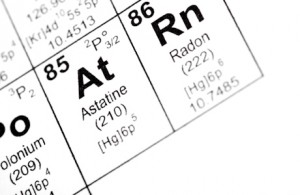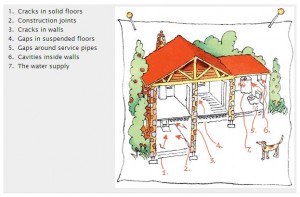Radon is a radioactive byproduct of radium. It is a part of the natural radioactive decay series, which is a group of naturally occuring radioactive elements such as Uranium, Radium and Thorium.
The Science Behind the Deadly Gas Radon
 Radon (222) is one of the elements produced during the radioactive decay chain of uranium (238), and the isotope radon (220) is produced by the decay of thorium (232). All of these elements, especially uranium, can be found in the Earth’s soil. Since radon is a gas as opposed to a solid, it can migrate or seep through a few feet of soil and other materials. That is how it makes its way into a residence and collects in abundance.
Radon (222) is one of the elements produced during the radioactive decay chain of uranium (238), and the isotope radon (220) is produced by the decay of thorium (232). All of these elements, especially uranium, can be found in the Earth’s soil. Since radon is a gas as opposed to a solid, it can migrate or seep through a few feet of soil and other materials. That is how it makes its way into a residence and collects in abundance.
Cohen, A. B., who wrote “Before It’s Too Late” (Plenum Press, 1983) said that approximately six atoms of radon are released by every square inch of soil every second. If the radon gas is released into the open air it is quickly diluted, thus it poses less of a threat. However, if it seeps into a home it can collect in great amounts causing serious health issues over an extended period of time.
The deadly gas radon is considered so dangerous because it makes its way into the lungs and clings to the inner linings. Once there, it continues to decay and cause radioactive poisoning which ultimately results in lung cancer. Radon is the second leading cause of lung cancer in the US, yet it’s the number one cause in non-smokers. It is responsible for the deaths of more than 20,000 Americans each year.
How Does the Deadly Gas Radon Enter a Residence?
 Since Radon occurs naturally in the Earth’s soil it can be a problem anywhere. It doesn’t matter where you live or what type of home you live in, nor does it matter whether or not you have a basement. Radon can be a problem anywhere. Since the gas is odorless, colorless and tasteless the only way to detect its presence is to test specifically for it.
Since Radon occurs naturally in the Earth’s soil it can be a problem anywhere. It doesn’t matter where you live or what type of home you live in, nor does it matter whether or not you have a basement. Radon can be a problem anywhere. Since the gas is odorless, colorless and tasteless the only way to detect its presence is to test specifically for it.
Radon has been known to shop up in the highest concentrations in the state of Iowa (U.S) and the Appalachian Mountain areas of Pennsylvania (U.S). Some of the highest radon levels of all time were detected in Mallow, Country Cork Ireland. Extremely high levels have also been discovered all across Canada. It’s not just a local issue (local being in the United States).
The deadly gas radon can enter homes through the process of diffusion, seeping in through concrete floors and walls, the water supply, cracks in the foundation and concrete slab, as well as cracks in the floors, walls, drains, sump pumps, joints and even through the pores of hollow-block walls. Long story short, there are many ways the deadly gas can enter a home.
While a large majority of new homes are built using radon resistant construction measures, it’s still possible for radon to make its way inside.
Radon can come from various building materials such as granite, concrete, gypsum board or sheet rock), bricks, and field stone. However, it is only rarely that radon is released by these materials in amounts that would cause an issue. Most of the radon gas decays while trapped below the surface, and what is released is a small amount that was actually near the surface. In homes constructed using these materials, if elevated levels are discovered it’s still likely the indication of another problem – a radon mitigation system is still recommended.
How to Remove the Deadly Gas Radon?
In order to lower the concentration of the deadly gas radon in a home where there’s a problem, you must install a mitigation system which essentially vents the contaminated air outside. Either the homeowner or a certified mitigation professional can install the equipment and system needed. It is always recommended, however that you hire a professional to do the work. This ensures it is done properly, and all equipment used remains safe and free of leaks.
In many cases, a radon professional will test before and after the installation of a mitigation system to ensure it is working properly.


